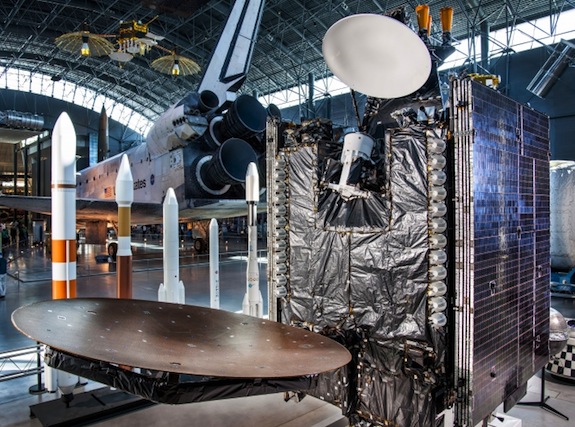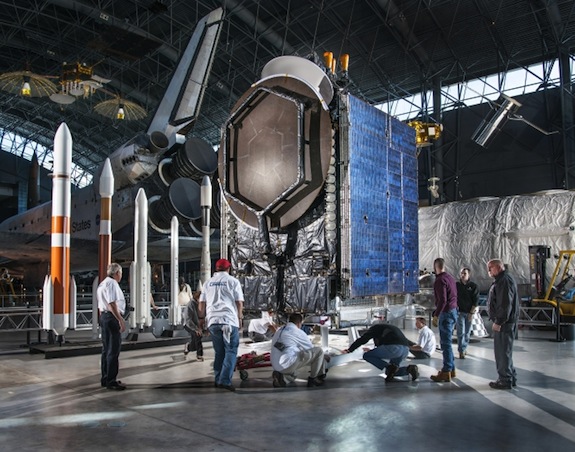Sirius Satellite Comes to Udvar-Hazy
An innovative part of communications history comes to the collection
![]()

The satellite (shown in its display at Udvar-Hazy) was a backup for an innovate three-satellite system for Sirius satellite radio. Photo by Dane Penland
No, Udvar-Hazy did not spring for a subscription to satellite radio and start listening to the all-Bruce Springsteen all-the-time station. It did, however, acquire a piece of communications history with the addition of a Sirius FM-4 broadcasting satellite.
That the technology, first conceptualized in the 1980s and launched in 2000, is now a piece of history just indicates how rapidly the industry is evolving as satellite technology becomes a greater part of every day life each year.
Satellite technologies only became a private enterprise a few decades ago. “One doesn’t even begin to think about the potential and beneficial use of communications satellites until the 1960s,” explains space history curator Martin Collins. NASA led the development with government programs but with the wave of privatization that peaked in the 70s and 80s, the industry went commercial. Largely used for broadcast television, satellite systems relied on what is called “geostationary orbit,” meaning the satellite orbited around the equator. Unfortunately for individuals dwelling in places distant from the equator, the signal could only reach so far.
At the time of its development, the SiriusXM satellite presented an innovative way to reach those consumers who had not been reached before by traditional satellite broadcasters. Using three satellites with a “highly inclined elliptical orbit,” SiriusXM was able to bring satellite radio to a greater geographic area. An ingenious solution, the strategy required more elaborate technologies. “When you use highly elliptical orbits,” says Collins, “you have to use more sophisticated approaches to tracking the satellite, to communicating with the satellite, to adjusting its orbit, to maintaining high performance, so you have these additional complicating factors.”

A team installs the new acquisition early Tuesday October 16. Photo by Dane Penland
Over time, the industry caught up and can now produce single satellites that are capable of reaching distant consumers even while utilizing a geostationary orbit. “The new generation of their satellites are bigger, have more power, and use larger antennas to transmit their signals,” Collins explains.
There is one pretty large exception when it comes to phasing out highly elliptical orbits: Russia. The country began using the technology when it was still part of the Soviet Union and continues to use it because so much of its land mass is at high latitudes.
Developed under Robert Briskman, SiriusXM’s advances are part of what Collins says is an incredible shift away from ground-based communications. One of the greatest hallmarks of the early age of radio, begun more than 100 years ago, are the skeletal towers that transmit radio waves across the Earth’s surface. “One of our material cultural aspects of the 20th century is seeing these very tall towers around communities, whether it’s to broadcast television or radio,” says Collins. “With the Space Age, one in essence has the ability to elevate those towers above Earth and broadcast down and thus reach much greater geographic areas than one could do previously.”
Not only does the Sirius FM-4 satellite, which was built by Space Sytems/Loral for Sirius as a backup for the three-satellite system, represent a breakthrough in commercialized Space Age communications, it signals a broader shift that has remade our built environments and our daily experience.
“I think this move that sort of happened in the 80s and 90s to provide directly to individuals these kinds of satellite services, whether it was television or, in the case of Sirius, digital radio in your automobile or your home, were major, major transformations,” Collins says. Though he cites our rapacious appetite for entertainment, he says there are other notable integrations of the Space Age into daily life, from GPS in our cars to the very infrastructure of the business community.
/https://tf-cmsv2-smithsonianmag-media.s3.amazonaws.com/accounts/headshot/Leah-Binkovitz-240.jpg)
/https://tf-cmsv2-smithsonianmag-media.s3.amazonaws.com/accounts/headshot/Leah-Binkovitz-240.jpg)